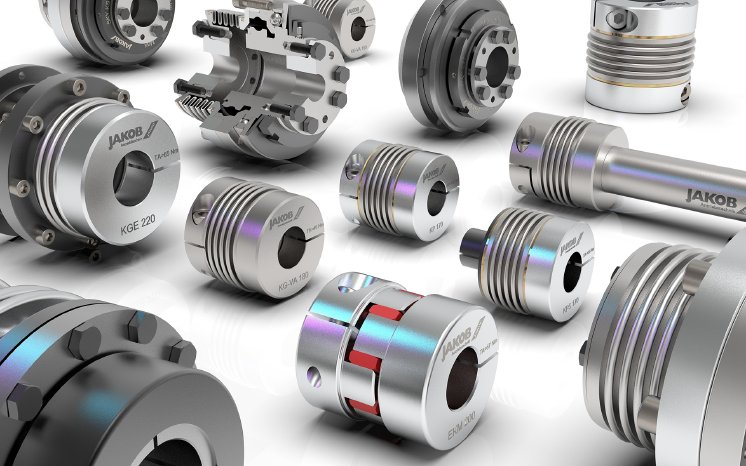When do you need a servo coupling?
A coupling initially connects two shaft journals. However, even a minimal misalignment of the shafts or fluctuations in the ambient temperature can lead to uneven running, which is reflected in increased wear on the bearings, greater noise or even damage to the entire drive train.
Bellows couplings are very torsionally rigid in the direction of rotation, which means they hardly twist in on themselves. Laterally, however, they are flexible, which allows them to compensate for misalignment. Low restoring forces, the absolutely backlash-free torque transmission and the flexible application options make them an indispensable component in mechanical engineering today. Metal bellows couplings are particularly effective at high speeds and precise applications.
Elastomer couplings have a dampening effect on vibration instead of passing it on to the next component. With this type of compensating coupling, it is also important to ensure that the alignment is as precise as possible, but the risk of damage is much lower.
Safety couplings can be based on bellows or elastomer couplings, but have a torque limiter as overload protection. This reliably prevents costly machine damage, repairs and downtime.
If the set torque is exceeded, the drive is mechanically disconnected.
With its extensive modular system, JAKOB Antriebstechnik GmbH offers an optimal variant for every application. Combinations of metal bellows, safety, elastomer and spacer couplings are also possible.
Where do you need servo couplings?
Torque transmission is a necessity in almost all technical systems. The more dynamic and precise a system is to work, the more careful attention must be paid to the drive and the area of the shaft connections - the couplings.
Servo couplings can be used in highly dynamic feed axes of machine tools or are suitable for demanding drives in general mechanical engineering. They can be found in industrial robots, servo and stepper motor applications. Due to the increased use of servo drives with their high dynamics, ever more perfect couplings are in demand. Even if the drive elements are manufactured with high precision: the unavoidable axis shifts in the hundredth of a millimeter range must be compensated. The backlash-free metal bellows couplings are particularly suitable here, which are equipped with additional functions and also protect the machine as safety brakes.
What are servo (compensating) couplings?
Servo couplings are compensating couplings for the backlash-free, angle-accurate transmission of torque with the highest possible torsional rigidity and the lowest possible moment of inertia. Elastomer couplings with a flexible polyurethane star can also be a sensible alternative for a wide range of applications due to their product-specific advantages. What all servo couplings have in common is the absolute freedom from backlash (also shaft-hub connection) and the flexibility to compensate for shaft misalignment. As spacer couplings or as universal joints, they bridge distances of up to six meters without intermediate storage. As miniature couplings, they are designed for the offset or axial displacement of two axes. Various designs are available for different applications such as NC axes, stepper motors, robot drives, linear units, handling devices, angle encoders or servo drives. They are available as bellows couplings, elastomer couplings or cross slide couplings. Equipped with an additional safety function, servo compensation couplings also serve as overload protection and torque limiters and protect expensive systems from costly machine damage. Stainless steel bellows with various designs, polyurethane stars with different shore hardnesses or cross slide parts made of polyacetal are used as flexible compensation elements.
How to choose the right servo coupling
In order to find the right coupling for a drive train, a number of factors must be taken into account. The required torque range, the offset and the ambient temperatures of the coupling are particularly important. The distance to be bridged between the shafts, electrical conductivity or insulation, use in potentially explosive areas, particularly high speeds or torques and many other factors also influence the choice of the right servo coupling.
First, the required maximum torque is determined. The coupling should be selected accordingly and not used permanently with overload or in the absolute limit range.
The misalignment goes hand in hand with the possible service life, because the greater the misalignment, the lower the life expectancy of the coupling. It is therefore essential to ensure that the alignment is as precise as possible. The compensable lateral offset is in the range of around 0.15 - 0.3mm. This also depends heavily on the number of bellows corrugations. A 4-shaft coupling achieves several times higher possible offset values than a 2-shaft coupling. Basically, the lateral displacement is the most important factor to consider after the torque, as it has a major impact on the possible power transmission. A high offset can also lead to uneven running, which can be reflected in increased wear, greater noise or even damage to the entire drive train.
When measuring the maximum operating temperature, it is also important to take into account the possible heat development of the machine and its components during operation. The choice of material for the couplings is also important in this context. The often used, lightweight aluminum is replaced by stainless steel components, for example, at very high maximum temperatures. While steel or stainless steel couplings can be connected using a special micro-plasma welding process, this method is not suitable for combinations of aluminum and steel. Adhesive processes can be used here, but these can fail under extreme operating conditions (chemicals, very high or low temperatures). Especially with couplings on the input side of a planetary gear, high temperatures can occur in critical applications, which could loosen the adhesive connections.
The joining process (flaring press-in process) developed by JAKOB and patented for a long time, however, is ideal for joining multi-layered stainless steel bellows to aluminum hubs without play. Operation is also possible in temperature ranges from -50°C to +350°C.
Once all criteria have been taken into account, a suitable coupling can be selected. If in doubt, the manufacturer will be happy to advise you.


